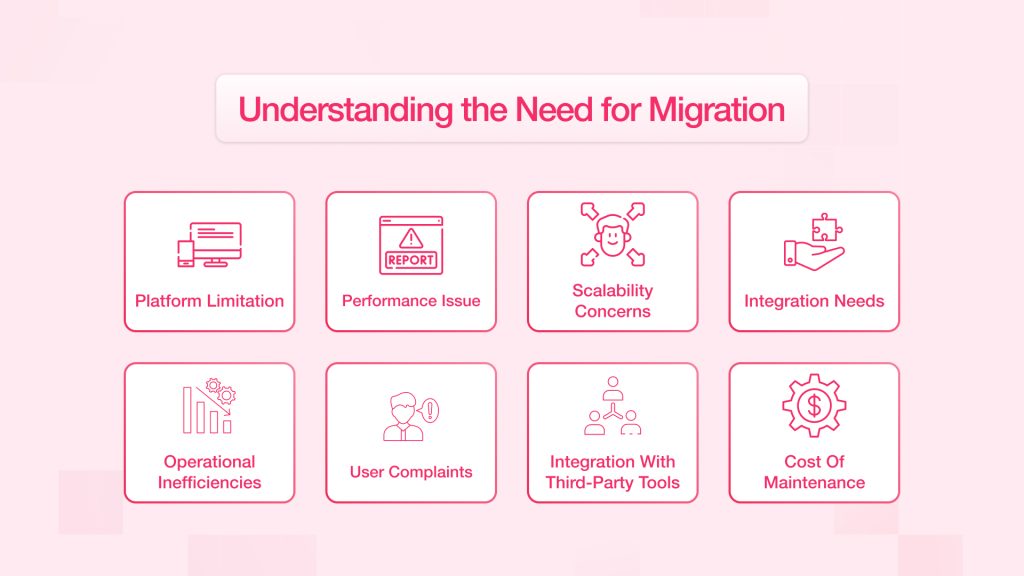Migrating Your Ecommerce Site: Painful or Powerful? Tips for successful migration
Migrating your eCommerce website is an awesome opportunity for your growth, but it is indeed daunting. Implementation-wise, realising concrete tips in the eCommerce migration process, minimising risks, protecting SEO rankings, and ensuring a smooth transition will help evolve your business further into the future.
- June 27, 2025
- by Tarun


Migration of your eCommerce site is indeed a complex and challenging task, but with effort placed in proper planning and execution, it could very well become a transformational opportunity to grow the business. Your reasons might be that you want to move over to a better ecommerce platform, consolidate several stores, or just achieve better scalability. The whole process requires a close, detail-oriented approach. This article will cover several implementing tips for successful eCommerce migration with a focus on planning, data management, SEO preservation, UX, and post-migration steps.
Understanding the Need for Migration
Before heading into the successful ecommerce migrations, it’s best to check if it is the right time for your business to do so. Consider factors such as:

- Platform Limitation: Is your current platform hindering growth or missing features that are essential? If yes, then you may have to migrate.
- Performance Issues: Site speed is too slow; the site goes down too often; the user experience is bad. Who would want to stay at such a site?
- Scalability Concerns: As your business grows, your platform should be able to handle larger traffic and transactions.
- Integration Needs: In some cases, integration with CRM, ERP, or marketing platforms is very important in the smooth operation of the business.
- Operational inefficiencies: In case your backend procedures, such as inventory management, order processing, or customer service, are passé or uncoordinated, your platform could be an impediment.
- User complaints: Continuing reports of slow load durations, poor navigation, or technical glitches are a clear indicator of the declining user experience.
- Integration with third-party tools: Outgrowing an eCommerce portal needs to integrate with email platforms, analytics tools, payment gateways, and logistics partners. If these integrations are estranged, then being unavailable may just mean a need for change.
- Cost of maintenance: As usual, legacy systems become more expensive to maintain due to outdated code or the absence of developer support. Investing in migration may provide a better long-term return.
Analysing these factors will tell whether migration is suitable for your business.
Planning and Preparation
A successful migration requires a well-thought-out plan.
Objective Clarity
Begin by clearly defining your business objectives:
- Is speeding up page load time your concern?
- Are new international markets your target?
- Maybe you need multi-store or multi-language features?
Other than these, any other variables could help you concoct a scenario that would aid primary technical and operational decisions during migration.
Team Assembly
The best migration team need more than just developers. Ideally, your team should have:
- Technical Project Manager: In charge of keeping tasks aligned with timelines.
- Ecommerce Developer: Knows the old ecommerce platform and the new platform.
- SEO Specialist: Takes care of ranking retention and implements proper redirections.
- Data Analyst: Recommends actually mapping and evaluating the accuracy of all moved data.
- UX/UI Designer: Ensures the front end fits your brand and meets user expectations.
Depending on whether you are putting that team together internally or outsourcing it, each of these roles is indispensable.
Detailed Roadmap
The entire migration should be split up into phases, including:
- Sandbox or staging environment provided for testing purposes.
- Content audit and migration plan.
- SEO asset migration (sitemaps, meta descriptions, canonical tags, etc.).
- Launch day process checklist.
- Post-launch QA plan.
Keep organised and maintain full visibility over progress with the help of tools like Gantt charts or software for tracking the migration.
Looking to Update or Migrate you Ecommerce Website?
Our Experts Can Help!
Data Management
Data is the backbone of your ecommerce operation, mainly product catalogues and customer profiles with transaction histories. A loss of such data or its misalignment will create a few operational challenges and, many times, highly disgruntled customers.

Backing Up Data
No matter how good the migration team is, always create full backups:
- Keep your backups version-controlled by organising them in cloud storage.
- Have all data structures for the current platform been documented?
- During the migration, do daily backups for your safety.
Data Mapping
You need to make your data mapping schemas before moving data. It is aligning each data field from your previous platform against the corresponding field in the new platform.
For example:
- SKU on Platform A may be called Product ID on Platform B.
- User profile fields could differ in name and structure.
Use automated migration tools with caution — always review their output to guarantee a clean transfer.
Data Cleansing
Eliminate redundant or obsolete data:
- Remove or deactivate user accounts or duplicate records.
- Archive order history beyond a certain age unless it’s legally required.
- Standardise product, category, and tag naming conventions.
After data cleaning and mapping, sample migrations should be executed, with final validation of the sample migration results to ensure correctness before continuing with the larger migration effort.
SEO Considerations
Migration can involve one of the most vulnerable areas for SEO, yet it often remains underestimated. Any flaws can lead to a considerable decline in traffic and revenue.
Full URL Mapping and Redirects
From a full URL map, ensure 301 redirects from all old URLs to their new counterparts. Never just delete an existing URL without first redirecting it.
Get tools like Screaming Frog to crawl the old site and export the complete list of URLs.
Retaining SEO Metadata
Every product and category page has metadata that helps it rank:
- Title tags
- Meta descriptions
- Image alt texts
- Structured data (schema markup)
Make sure this information is either transferred or recreated.
On-page and Technical SEO
Run SEO audits on both the sites:
- Clean sitemap maintenance
- Check that robots.txt does not inadvertently block crawlers
- Check canonical tags and header tag structure where applicable.
- Ensure pages are crawlable and indexed post-launch.
Track the ranking of your top 100 landing pages for a minimum of 60 days after the migration.
Need technical SEO guidance and support to boost your website rankings?
Our Experts Can Help!
Design and User Experience
There is an immediate effect of the frontend experience received by the clients. It is oftentimes an area where a certain migration gives an opportunity to alter the look of the site and its functional design.
Mobile Optimisation
With more than half of the eCommerce traffic generated from mobile devices, any design has to be truly mobile-first. These include:
- Touch-friendly buttons
- Responsive grids and product galleries
- Lightweight and fast images optimised for mobile
Run the site through Google’s Mobile-Friendly Test to validate.
Want to make your website mobile friendly? Here’s how you can do it.
Simplified Navigation
Bad navigation structures confuse users and discredit SEO. During the migration:
- Audit your menu categories for redundancy or complexity.
- Keep your menus no more than three levels deep.
- Provide them with breadcrumbs for easy backtracking.
Improved Checkout
A cart abandonment issue can be resolved through redesigning of the checkout process:
- Reduce the amount of information needed.
- Allow for a purchase by guests.
- Payment can be enabled by several means, such as digital wallets.
Be clear about shipping charges and return policies.
Testing and Quality Assurance
A thorough round of testing before and after migration mitigates damage beyond repair and user frustration.
Pre-Migration Testing
Test your staging environment for:
- Functional components (cart, filters, search).
- Page speed and server response times.
- Data correctness (products, pricing, and user accounts).
Gather feedback from usability testing with a sample group.
Post-Migration Testing
Right after going live:
- Monitor server logs for crawl errors.
- Crawl the whole of the new site.
- Check for page load speeds via different browsers and devices.
Fix whatever comes up within the first 72 hours when traffic starts to level out.
Addressing Issues Promptly
Resolving any issues that may arise immediately is very important, so as to limit disruption and maximise positive user experience.
Continuous testing will ensure the reliability and performance of the site.
Post-Migration Execution
Continuing the process after launching a migration involves refinement and monitoring.
Performance Monitoring
Use tools like:
- Google Search Console (to find issues with crawling).
- Google Analytics (to check for variations in user behaviour).
- Core Web Vitals (to keep track of speed and interactivity).
Put data from before and after migration side-by-side to determine the extent of change in impact.
Customer Feedback
Observe the growth in the number of support requests or complaints. Periodically send out user surveys or solicit feedback through emails or purchase questionnaires.
Such feedback brings forth the kinds of issues faced in real-world usage that metrics could be missing.
Iterative Improvements
Keep a log of all features or optimisations that were not considered for implementation before launch. They should be prioritised into sprints or phased rollouts.
Continue A/B testing for homepage banners, CTAs, product page layouts, etc., for conversion rate optimisation.
Mistakes to Avoid
Some errors can seriously affect migration success. They include:
- Launching Without Testing: Small bugs and glitches like broken filters or faulty image resolutions all have the capacity to trash your brand credibility.
- No Redirects: The absence of a redirecting strategy can completely diminish your SEO presence within the shortest possible time.
- Ignoring Analytics Setup: Check that GA4 (Google Analytics 4) or any other analytics platform is set up properly on the new site before the launch.
- Migrating During Peak Season: Never ever launch close to major sales events. Always use a slower period as a transition and troubleshooting window.
- Skipping Training: Training is necessary for internal teams on the new CMS platform and workflows, else they will slow down operations.
Conclusion
Migration cannot ever be a truly “set it and forget it” process. It is a moment of change filled with risks and yet infinite possibilities. The tips for successful eCommerce migration in this guide follow tested principles of current practice that stem from actual experience in various industries.
With flawless execution, migration can keep your existing performance intact and act as a building block for growth in the future. Begin with clarity, tread with caution, and keep the learning train chugging along.
If you’re planning to do a migration, bear in mind: being prepared, working with communication, and being watchful of technical factors, as well as the user experience, contribute towards your success!
 Shopify
Shopify

















